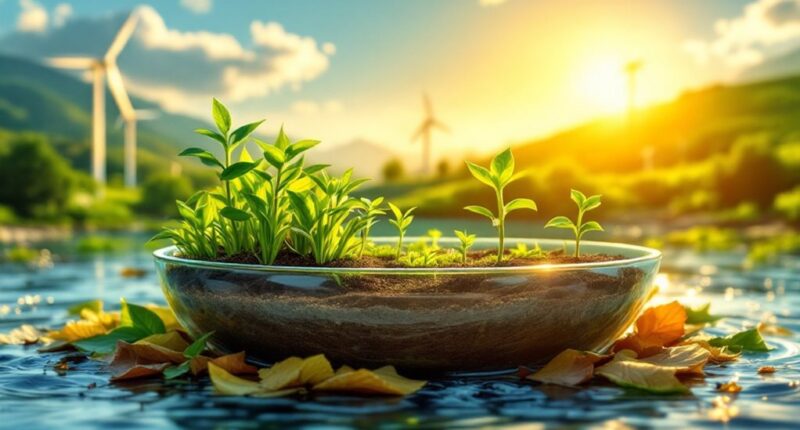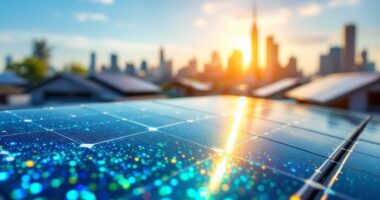Sustainability 101 centers on three interconnected pillars: environmental stewardship, social equity, and economic viability—often called the “triple bottom line.” This balanced approach guarantees that we meet today’s needs without compromising future generations’ resources. Key concepts include circular economy practices, carbon footprint reduction, and renewable energy adoption. The UN’s 17 Sustainable Development Goals provide a global roadmap for sustainable action. Explore these principles, and you’ll discover how small changes can collectively create significant positive impacts.

Sustainability stands as the cornerstone of our collective future, a concept both deceptively simple and infinitely complex. At its heart lies a beautifully straightforward idea: meeting today’s needs without borrowing against tomorrow’s possibilities. Like a well-balanced financial portfolio, true sustainability requires diversification across environmental protection, social equity, and economic viability—the famous “triple bottom line” that sustainability experts love to mention at dinner parties.
These three pillars of sustainability aren’t just coexisting roommates—they’re more like members of a band who must play in harmony. Environmental stewardship protects our ecological systems and biodiversity; social equity guarantees everyone gets a fair shake at resources and opportunities; and economic viability keeps the lights on while we figure everything else out. When one pillar weakens, the whole structure wobbles precariously. We must ensure a cosmic handshake between humanity and the planet to maintain this delicate balance.
The sustainability toolbox contains some nifty concepts for tackling our planetary challenges. The circular economy—nature’s way of saying “waste not, want not”—transforms yesterday’s trash into tomorrow’s treasure. Carbon footprints help us track our greenhouse gas emissions, much like a dieter counting calories. Meanwhile, renewable energy sources—solar, wind, hydroelectric, and geothermal—stand ready to power our world without the planetary hangover of fossil fuels. These fundamentals are taught through interactive content and real-world business cases in modern sustainability education.
Climate change looms large in any sustainability conversation. Those pesky greenhouse gases—CO₂, methane, nitrous oxide, and water vapor—are wrapping Earth in an increasingly warm blanket, leading to extreme weather events that make hurricane season look like must-see TV. Addressing this challenge requires both mitigation (reducing emissions) and adaptation (preparing for changes already in motion).
The United Nations’ 17 Sustainable Development Goals provide a global roadmap toward a better 2030, tackling everything from poverty to pollution. Businesses are discovering that sustainability isn’t just good karma—it’s good business, driving innovation, brand loyalty, and employee engagement. For individuals, sustainability means making mindful choices about energy, waste, transportation, and consumption. Small actions, multiplied by billions, create the sustainable world we all hope to inhabit tomorrow.
Frequently Asked Questions
How Can Individuals Measure Their Personal Sustainability Impact?
Individuals can measure their sustainability impact through various tools and practices.
Carbon footprint calculators assess emissions from energy use, transportation, and waste. Smart devices track real-time resource consumption, while utility bills provide monthly data. Waste can be quantified by weighing trash and recycling.
Ecological footprint assessments evaluate overall resource demands. Food carbon calculators examine dietary impacts, and transportation logs monitor travel methods.
These measurements help people understand their environmental influence and identify improvement opportunities.
What Economic Incentives Exist for Businesses Adopting Sustainable Practices?
Businesses adopting sustainable practices can access numerous economic incentives. These include tax credits for renewable energy equipment and electric vehicles, grants for green innovation, and various subsidies. Companies also enjoy cost savings through reduced utility bills and waste management fees.
Market advantages emerge as environmentally conscious consumers often pay premium prices for sustainable products. Additionally, sustainable businesses typically experience enhanced brand reputation, better access to capital, and competitive advantages through green innovation.
How Do Cultural Differences Affect Sustainability Implementation Globally?
Cultural differences substantially shape sustainability implementation globally. Values like collectivism versus individualism determine whether initiatives should target communities or individuals. Some cultures prioritize long-term planning while others focus on immediate results.
Varying relationships with nature influence conservation approaches. Communication styles (high-context versus low-context) affect how sustainability messages resonate. Additionally, cultural attitudes toward authority impact regulatory compliance, while traditional knowledge systems contribute unique sustainable solutions that might be overlooked in standardized global approaches.
Can Sustainability and Economic Growth Coexist Effectively?
Evidence suggests that sustainability and economic growth can indeed coexist effectively. The concept of “green growth” demonstrates how countries have successfully decoupled economic expansion from carbon emissions. Businesses implementing sustainable practices often experience improved profitability and risk mitigation.
While challenges remain—particularly implementation costs and resistance from traditional industries—innovations in clean energy, circular economy principles, and strategic policy frameworks create pathways where economic advancement and environmental stewardship reinforce rather than oppose each other.
What Emerging Technologies Are Revolutionizing Sustainability Efforts?
Emerging technologies are transforming sustainability across multiple fronts. AI and machine learning optimize energy grids and enhance precision agriculture. Advanced energy technologies like perovskite solar cells and offshore wind platforms expand renewable options.
Circular economy innovations turn waste into resources through AI-driven sorting systems and biodegradable materials. Meanwhile, transportation evolves with improved electric vehicles, autonomous systems, and vehicle-to-grid solutions that integrate with smart city infrastructure, creating broad sustainability ecosystems.









